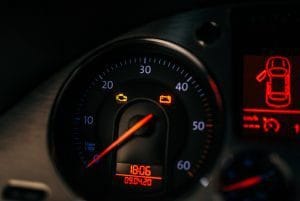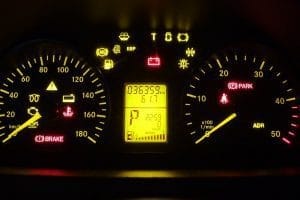Blowby is an engine problem in which the gases from the combustion chamber leak into the crankcase from the space present in between the piston rings and cylinder bore walls.

Symptoms of Blowby
- The vehicle is unable to pull
- Smoke coming out from exhaust is bluish in color
- Poor pick-up and acceleration
- Excessive Engine Oil consumption
- An abnormal noise from the engine
Practical methods to check whether your engine has a blowby or not
- When you place a tissue in front of the exhaust, it will become wet because of oil vapors coming out from the exhaust.
- Smoke coming out from the exhaust will be slightly bluish in color, it happens when oil mixes with fuel and gets burned in the combustion chamber.
- You can carry out an oil consumption test, if the oil consumed by your vehicle is more than usual then, that’s a signal of oil-burning or oil leakage which are the main factors of blowby.
- Once you dismantle the engine you can check traces of dust particles in your cylinder, also check piston ring fitment, and any damage / uneven wear on piston rings.
- Check the air filter system, the filter should not be blocked.
Causes and corrective action for excessive BlowBy
Cause 1 : Due to Uneven Piston ring wear
Check-
Dismantle the engine and piston assembly and check the piston ring visually for any wear.
Repair-
Uneven piston ring wear occurs due to improper honing pattern in the cylinder bore or improper ovality and taperness parameters of the cylinder bore, so make sure to check the parameters and honing hatching lines while reassembling the engine.
Note-
- The value of ovality and taperness should not exceed 7-10 microns in the case of small engines and 10-12 microns in the case of large engines.
- Honing pattern is a hatching line, made during the honing process on the walls of cylinder bore so that during piston moment the oil can retain on the walls of the cylinder to prevent piston ring wear and act as a sealing layer between combustion chamber and crankcase.
Hatching lines are generally made at an angle of 45 degrees, the angle can differ from one manufacturer to another.
Note-
- Torque plate should be mounted on the top of the cylinder block before checking the ovality and taper valve of the cylinder bore, do not forget to sequence torque on the torque plate at specified torque value.
- The torque value of the torque plate is generally near around the torque spec. of cylinder head tightening bolts.
Cause 2 : Due to a clogged air filter
Check-
Check the condition of the air filter and its fitment along with air filter hoses.
Repair-
If the air filter found clogged then clean it with high pressurized air but if still, you find it dirty then replace the clogged filter with a new one.
Cause 3 : Due to scoring lines and dent marks on the cylinder bore surface
Check-
When we dismantle the engine to check the cause, we can observe visually that there are long scratch lines and dent marks present on the surface of the cylinder bore, this happens due to two reasons either due to the use of rough honing and boring sticks during honing/finishing operation in cylinder bore or due to dust and debris present in the oil.
When the piston moves in a reciprocating direction the dust gets trapped between the piston rings and cylinder bore surface which results in a long straight deep scratch line that allows leakage of compression chamber gases into the crankcase.
Repair-
Make sure to use clean air and oil filter, make sure that during assembly of the engine, no dust particles should be retained inside it, every part should be properly cleaned with a lint-free cloth.
Cause 4 : Due to incorrect piston ring fitment
Check-
After dismantling the engine check the gap between the piston ring and bore surface with the help of a feeler gauge, it should not go between the gap.
The gaps/cuts between the piston rings should not be in line as it may provide easy leakage of oil from the combustion chamber into the crankcase.
Repair-
While the assembly of piston rings make sure that the open gap in the piston rings should be placed 120 degrees apart from each other.
Note-
- There are three rings assembled on the piston, from top of a piston there are two compression rings and the last is an oil ring.
- The oil ring consists of a spacer placed in it, the function of the spacer is to expand the oil ring and press it on the sidewalls against the cylinder wall until the correct tension is achieved.
What is Crankcase Ventilation
Crankcase ventilation in an internal combustion engine is a process to remove unwanted gases from the crankcase, these gases generally leak from the combustion chamber to the crankcase through piston rings.
These unwanted gases are known as blowby.
In earlier days there was a road draught tube that was used to draw the gases from the crankcase with the help of a partial vacuum and release them to the atmosphere directly but after some time, the Positive crankcase ventilation system (PCV) was introduced which are generally used in most of the engines.
What is Positive Crankcase Ventilation (PCV systems)
A positive crankcase ventilation system (PCV) was introduced to send those leaked gases present in the crankcase again to the combustion chamber for re-ignition in order to reduce air pollution.
Note-
For the effective performance of the PCV system an oil and air separator is used, the purpose of using separator is to separate the oil vapors present in the crankcase gases from the air, as these oil vapors may gradually clog air filter during recirculation with time.
To prevent this, filters are provided with microfibre mesh which will hold the tiniest particle of oil vapors and will allow air to pass through it, back to the combustion chamber.
For the purpose of recirculating blowby gases for re-ignition, a fresh source of air needs to be sent in the crankcase, so for that purpose breather is used whose purpose is to supply fresh air in the crankcase which is deducted from the engine intake manifold.
Conclusion-
As per my personal experience as a quality engineer, blow-by occurs mainly due to improper piston bore parameters such as (ovality, taperness, improper honing pattern, scoring lines) or uneven piston ring wear and tear.
Why is Crankcase Ventilation important
Crankcase ventilation is important for our engine because it helps in releasing the unwanted gas present in the crankcase, so if gases are not removed then those gases will contaminate the oil present in the crankcase which may form sludge and may clog the filter.
These gases will also increase the temperature of engine oil which is not favorable for your engine.





